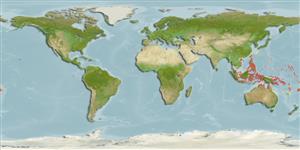>
Blenniiformes (Blennies) >
Blenniidae (Combtooth blennies) > Salariinae
Etymology: Blenniella: Diminutive of blennius, Greek,blenios = mucus (Ref. 45335).
More on author: Bleeker.
Environment: milieu / climate zone / depth range / distribution range
Ecologie
marien rifbewoner; diepte 0 - 2 m (Ref. 90102), usually 0 - 1 m (Ref. 9962). Tropical
Western Pacific: Taiwan to Indonesia and Efate, New Hebrides (Vanuatu).
Grootte / Gewicht / Leeftijd
Maturity: Lm ? range ? - ? cm
Max length : 6.0 cm SL mannelijk / geslacht onbekend; (Ref. 9962); 5.1 cm SL (female)
Korte beschrijving
Determinatiesleutels | Morfologie | Morfometrie
Dorsale stekels (totaal) : 12 - 14; Dorsale zachte stralen (totaal) : 18 - 21; Anale stekels: 2; Anale zachte stralen: 19 - 22; Wervels: 37 - 40. Dorsal fin XII-XIV, 18-21, notched between spinous and segmented-ray portions; anal fin II, 19-22; pectoral rays 12-15; pelvic fin I, 3. Vertebrae 11-12 + 26-28. Orbital cirrus simple filamentous; nasal cirri short and simple to palmate with 2-6 branches; nape with cirri. Lateral line, continuous anterodorsally below dorsal spines from 4th to 10th, disconnected posteroventrally up to below dorsal spine 7-8th to 12-13th. Mandibular pores 4-6 Lips margin entire. Occipital crest present only in males, and only 0.7 mm or lower. Meristic characters slightly vary geographically, increasing from north to south (Ref. 9962). Body depth at anal-fin origin 5.3-6.0 in SL. Male grey to dark brown with longitudinal rows of blue dashes. Female pale grey with dark horizontal dashes and vertical dark A/H-shaped bars; dorsal and caudal fins spotted (Ref. 90102).
Found solitary or groups (Ref. 90102) near-shore rocky areas, including tide pools and at depths usually less than 1 meter (Ref. 9962). Oviparous. Eggs are demersal and adhesive (Ref. 205), and are attached to the substrate via a filamentous, adhesive pad or pedestal (Ref. 94114). Larvae are planktonic, often found in shallow, coastal waters (Ref. 94114).
Levenscyclus en paargedrag
Maturiteit | Voortplanting | Paaien | Eieren | Fecunditeit | Larven
Distinct pairing (Ref. 205).
Springer, V.G. and J.T. Williams, 1994. The Indo-West Pacific blenniid fish genus Istiblennius reappraised: a revision of Istiblennius, Blenniella, and Paralticus, new genus. Smithson. Contrib. Zool. 565:1-193. (Ref. 9962)
Status op de Rode Lijst van het IUCN (Ref. 130435: Version 2024-2)
Gevaar voor de mens
Harmless
Gebruik door de mens
Tools
Speciale rapporten
Download XML
Internetbronnen
Estimates based on models
Preferred temperature (Ref.
123201): 27.4 - 29.4, mean 28.8 °C (based on 963 cells).
Fylogenetische diversiteitsindex (Ref.
82804): PD
50 = 0.5020 [Uniqueness, from 0.5 = low to 2.0 = high].
Bayesian length-weight: a=0.00776 (0.00356 - 0.01695), b=3.00 (2.81 - 3.19), in cm total length, based on LWR estimates for this (Sub)family-body shape (Ref.
93245).
Trofisch niveau (Ref.
69278): 2.9 ±0.3 se; based on size and trophs of closest relatives
Weerstandsvermogen (Ref.
120179): Hoog, minimale populatieverdubbelingstijd minder dan 15 maanden (Preliminary K or Fecundity.).
Fishing Vulnerability (Ref.
59153): Low vulnerability (10 of 100).
Nutrients (Ref.
124155): Calcium = 243 [110, 478] mg/100g; Iron = 1.02 [0.53, 1.93] mg/100g; Protein = 17.9 [16.5, 19.1] %; Omega3 = 0.0718 [, ] g/100g; Selenium = 15.3 [6.4, 39.0] μg/100g; VitaminA = 143 [33, 641] μg/100g; Zinc = 3.4 [2.1, 5.3] mg/100g (wet weight);
